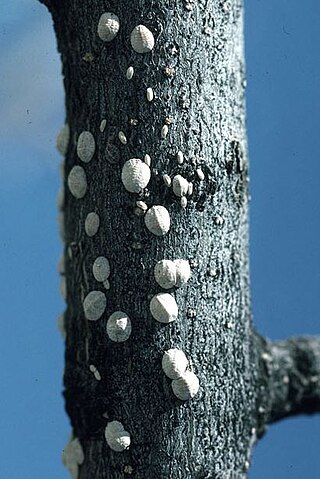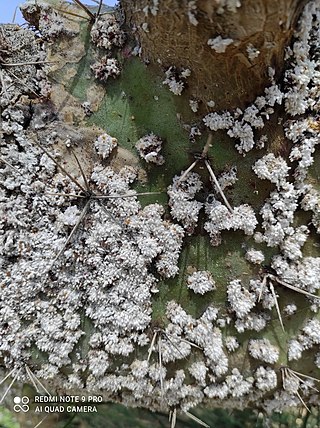
Whiteflies are Hemipterans that typically feed on the undersides of plant leaves. They comprise the family Aleyrodidae, the only family in the superfamily Aleyrodoidea. More than 1550 species have been described.

Scale insects are small insects of the order Hemiptera, suborder Sternorrhyncha. Of dramatically variable appearance and extreme sexual dimorphism, they comprise the infraorder Coccomorpha which is considered a more convenient grouping than the superfamily Coccoidea due to taxonomic uncertainties. Adult females typically have soft bodies and no limbs, and are concealed underneath domed scales, extruding quantities of wax for protection. Some species are hermaphroditic, with a combined ovotestis instead of separate ovaries and testes. Males, in the species where they occur, have legs and sometimes wings, and resemble small flies. Scale insects are herbivores, piercing plant tissues with their mouthparts and remaining in one place, feeding on sap. The excess fluid they imbibe is secreted as honeydew on which sooty mold tends to grow. The insects often have a mutualistic relationship with ants, which feed on the honeydew and protect them from predators. There are about 8,000 described species.

The Margarodidae or ground pearls are a family of scale insects within the superfamily Coccoidea. Members of the family include the Polish cochineal and Armenian cochineal and the original ground pearl genus, Margarodes. Beginning in 1880, a number of distinct subfamilies were recognized, with the giant coccids being the first. Although Maskell proposed a new family, many continued to regard the monophlebids as a mere subfamily for many years, and the Margarodidae classification continued to be polyphyletic through the 20th Century. Since then, taking the advice of Koteja several subfamilies and tribes have been elevated into their own families such as Matsucoccidae and Xylococcidae. The pared-down family of Margarodidae is monophyletic.

Eriococcidae is a family of scale insects in the order Hemiptera. They are commonly known as felt scales or eriococcids. As of 2023, there are 109 genera and 681 species. Each species is usually specific to a different plant host, or closely related group of hosts.

Halimococcidae is a family of scale insects in the order Hemiptera. Members of the family are commonly known as pupillarial palm scales or halimococcids. Most species are found on the leaves of palm trees where they suck sap, but some species occur on Pandanus. The family was named by Brown and McKenzie in 1962 and includes five known genera and twenty one species.

Cerococcidae is a family of scale insects commonly known as ornate pit scales or cerococcids. There are 83 species in 5 genera. Members of this family occur in all regions of the world.
Asterolecaniidae is a family of scale insects commonly known as pit scales or asterolecaniids. They typically cause a depression in the host plant's tissues and often cause distortion of the shoots. They are found on a range of hosts but are especially common on oaks, bamboos and a number of ornamental plants. Members of this family occur in most regions of the world but are most abundant in the northern hemisphere. There are about 25 genera and 243 recorded species.

Beesoniidae is a family of scale insects commonly known as beesoniids. They typically cause galls on their plant hosts. Members of this family mostly come from southern Asia. The family name comes from the type genus Beesonia which is named after the entomologist C.F.C. Beeson who obtained the specimens from which they were described and named.
Carayonemidae is a family of scale insects commonly known as carayonemids. They typically live among mosses and leaf litter which is unusual for scale insects. Members of this family come from Neotropical areas of South and Central America.

Lecanodiaspididae is a family of scale insects commonly known as false pit scales or lecanodiaspidids. Members of this family come from all parts of the world but are most numerous in the Far East.
Micrococcidae is a family of scale insects commonly known as the Mediterranean scales. There are two genera and eight species. Members of this family are found in Cyprus, Italy and other Mediterranean countries including Egypt, France, Greece, Israel, Lebanon, Libya, Syria and Turkey.

Monophlebidae is a family of scale insects commonly known as the giant scales or monophlebids. They occur in most parts of the world but more genera are found in the tropics than elsewhere.
Phenacoleachiidae is a family of scale insects commonly known as the phenacoleachiids. They are found only in the South Island of New Zealand, and on certain offshore islands. There are two species in a single genus.
Putoidae is a family of scale insects commonly known as giant mealybugs or putoids. There is probably a single genus, Puto, containing about sixty species. The genus name Macrocerococcus has also been used but it is now considered to be a synonym of Puto. The genus Puto was formerly classified as a member of the Pseudococcidae; however, it so significantly differed from the rest of the Pseudococcidae that it was accorded its own family Putoidae.

Cylindrococcus is a genus of scale insects that induces galls on plants of the genus Allocasuarina. There are two described species of Cylindrococcus, both of which occur only in Australia. The galls of adult females look somewhat similar to the cone-like "fruit" of the host plant and might be mistaken for such.

Planococcus citri, commonly known as the citrus mealybug, is a species of mealybugs native to Asia. It has been introduced to the rest of the world, including Europe, the Americas, and Oceania, as an agricultural pest. It is associated with citrus, but it attacks a wide range of crop plants, ornamental plants, and wild flora.

Dactylopius is a genus of insect in the superfamily Coccoidea, the scale insects. It is the only genus in the family Dactylopiidae. These insects are known commonly as cochineals, a name that also specifically refers to the best-known species, the cochineal. The cochineal is an insect of economic and historical importance as a main source of the red dye carmine. It has reportedly been used for this purpose in the Americas since the 10th century. Genus Dactylopius is also important because several species have been used as agents of biological pest control, and because several are known as invasive species.

Pseudaulacaspis pentagona, the white peach scale or mulberry scale, is a species of armoured scale insect in the family Diaspididae. This scale infests over 100 different genera of plants including many fruit trees and ornamentals.

Planococcus ficus, commonly known as the vine mealybug, is a species of mealybug, belonging to the family Pseudococcidae, native to tropical and subtropical regions. The vine mealybug is found in Europe, Northern Africa, Southern Africa, the Americas, and the Middle East. The vine mealybug is invasive to weedy plants in many different regions of the world.

Dactylopius opuntiae, also known as the prickly pear cochineal, is a species of scale insect in the family Dactylopiidae.














